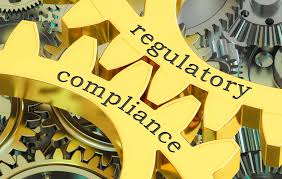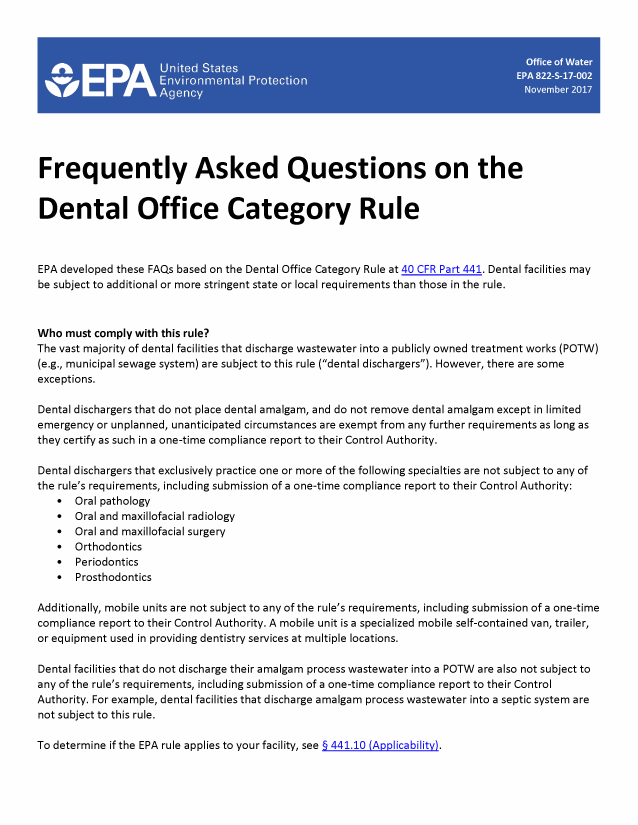Regulations


EPA Final Rule on Hazardous Waste Pharmaceuticals
FAQ: EPA Final Rule on Hazardous Waste Pharmaceuticals
Effective August 21, 2019, healthcare facilities and other businesses that generate pharmaceutical hazardous waste are required to manage those products according to the provisions of the Environmental Protection Agency’s (EPA) Management Standards for Hazardous Waste Pharmaceuticals (HWP) and Amendment to the P075 Listing for Nicotine Final Rule.More: success.ada.org
Management Standards for Hazardous Waste Pharmaceuticals and Amendment to the P075 Listing for Nicotine - www.epa.gov
Nevada
Nevada Division of Environmental Protection - ndep.nv.gov
Amalgam Separators FAQs

Dental Effluent Guidelines - Sample Compliance Report
www.epa.gov
EPA ONE-TIME COMPLIANCE REPORT FOR DENTAL DISCHARGERS to Comply with 40 CFR 441.50
Effluent Limitations Guidelines and Standards for the Dental Office Category
The Dental Effluent Guidelines Rule found in 40 CFR Part 441 applies to dental dischargers as defined in §441.10 and §441.20(e). Dental dischargers in business prior to the effective date of the Rule (July 14, 2017) have a deadline of July 14, 2020 to meet compliance with the Rule and submit a one-time compliance report. Dental dischargers beginning business on or after July 14, 2017 must comply with the Rule and submit a compliance report within 90 days following startup.
Sample Report: EPA_R9_dental-certification_sample-form__Nevada
Seven Things to Know about the EPA's Amalgam Rule
EPA ONE-TIME COMPLIANCE REPORT FOR DENTAL DISCHARGERS to Comply with 40 CFR 441.50
Effluent Limitations Guidelines and Standards for the Dental Office Category The Dental Effluent Guidelines Rule found in 40 CFR Part 441 applies to dental dischargers as defined in §441.10 and §441.20(e). Dental dischargers in business prior to the effective date of the Rule (July 14, 2017) have a deadline of July 14, 2020 to meet compliance with the Rule and submit a one-time compliance report. Dental dischargers beginning business on or after July 14, 2017 must comply with the Rule and submit a compliance report within 90 days following startup.
Sample Report: EPA_R9_dental-certification_sample-form__Nevada
After years of working with the ADA and addressing dentists' concerns, the Environmental Protection Agency (EPA) released a final rule on Dec. 15 requiring dental practices nationwide to install amalgam separators. Here are seven things you need to know about the rule:
1. The ADA believes this new rule, which is a federal standard, is preferable to a patchwork of rules and regulations across various states and localities.
2. The new rule meets the nine principles established by the ADA House of Delegates as a condition for ADA support for a national rule.
3. The ADA has developed a number of resources to aid member dentists with questions they may have regarding compliance. These resources are available at ADA.org/RecycleAmalgam.
4. Most dentists will not be required to comply with the rule until three years from now, at the end of 2019. Dentists who already have separators are “grandfathered in” for 10 years. Offices that open after the effective date will need to be in compliance upon opening.
5. The rule closely follows ADA's own best management practices (BMPs) and incorporates three of those BMPs:
- Requires use of separators;
- Prohibits flushing waste amalgam (including waste from traps or filters) down the drain; and
- Prohibits the use of bleach or chlorine-containing cleaners that may lead to the dissolution of mercury from amalgam when cleaning chair-side traps and vacuum lines.
6. A number of dentists are exempt from the rule, including:
- Dentists who practice in oral pathology, oral and maxillofacial radiology, oral and maxillofacial surgery, orthodontics, periodontics, and prosthodontics;
- Dentists who do not place amalgam and only remove amalgam in unplanned or emergency situations (estimated at less than 5 percent of removals); and
- Dentists who operate mobile dental units.
7. Since 2013, ADA's Business Resources has partnered with HealthFirst, a vendor that offers ADA member dentists special pricing on an amalgam separator device that will meet the federal regulatory requirements. Learn about the due diligence that was performed before extending this endorsement.
To learn more about the rule and explore ADA resources for member dentists, visit ADA.org/RecycleAmalgam.
Osha Compliance
Nevada operates an OSHA-approved State Plan covering most private sector workers and all state and local government workers.
Contact:
Nevada Occupational Safety and Health Administration
3360 West Sahara Avenue, Suite 200
Las Vegas, NV 89102
Tel: (702) 486-9020
Fax: (702) 990-0358
https://www.osha.gov/dcsp/osp/stateprogs/nevada.html
Radiology Requirements
Pursuant to NAC 631.260, the licensed dentist must provide a certified statement to the Board that his personnel received adequate training in radiographic procedures.
Pursuant to NAC 631.220, dental assistant’s duties are defined under the employ, authorization and supervision of the licensed dentist. This scope of practice defines the duties you may perform. If you are asked to perform a duty not set forth in NAC 631.220, you may contact the Board office to ensure compliance with this regulation.
Read more at: Nevada State Board of Dental Examinershttp://dental.nv.gov/Licensure/Dental_Assistants/
Opioid Prescriber Information
E-Prescribing 2021
Electronic Prescribing Mandate for Controlled Substances and Exemption Formhttps://bop.nv.gov/
Frequently Asked Questions
FAQ'sDownloadable sample forms, Downloadable Poster and Brochures, AB 474 Information
NDA Rx Faqs
Member Access
Compliancy Group - (HIPPA)

One stop shop for all things HIPAA, a new member benefit provided to help all members with their practices internal HIPAA compliance. https://compliancy-group.com/
Regulatory & Compliance Agency Links
Nevada State Board of Pharmacy
In regulating the practice of pharmacy, The Nevada State Board of Pharmacy has a duty to carry out and enforce the provisions of Nevada law to protect the health, safety and welfare of the public.
For Opioid Presciber information and to view Nevada Revised Statutes Online - Nevada Statutes and Regulations
Nevada State Board of Dental Examiners
Dental License Renewal
https://dental.nv.gov/
Nevada Division of Environmental Protection
All Federal EPA Forms, (EPA Form 8700-12/Site Identification Form) are provided at: Nevada Department of Conservation and Natural Resources Division of Environmental Protection 901 S Stewart Street, Suite 4001Carson City, NV 89701-5249
Skylar Jones:(775)687-9464
s.jones@ndep.nv.gov
Occupational Safety and Health Administration
Reno State Plan Office
4600 Kietzke Lane, Suite F-153
Reno, NV 89502
Business Hours: 8:00am - 5:00pm PT
(775) 688-3700
(775) 688-1378 FAX
Las Vegas State Plan Office
3360 West Sahara Avenue, Suite 200
Las Vegas, NV 89102
Business Hours: 8:00am-5:00pm PT
(702) 486-9020
(702) 990-0358 FAX
OSHA Area Office
The federal OSHA office covers only federal agencies; the United State Postal Service; private sector maritime; employment on Indian Lands; and areas of exclusive federal jurisdiction.
Las Vegas Area Office
US Department of Labor - OSHA
333 Las Vegas Blvd. South, Suite 5520
Las Vegas, NV 89101
(702) 388-6150
(702) 388-6160 FAX
On-Site Consultation Program
Nevada On-site Consultation Program
Health Insurance Portability and Accountability Act (HIPAA)
NEVADA HIPPA RESOURCES
Administration Office
1100 East William Street, Suite 101
Carson City, NV 89701
Telephone: (775) 684-3676
Fax: (775) 687-3893
Out-of-state toll free: 1-800-992-0900
Email DHCFP
Hours: Monday - Friday, 8am to 5pm
More: http://dhcfp.nv.gov/Contact/Contact_Home/
Nevada Division of Insurance
The Insurance Division is charged with protecting the rights of the consumer and the public’s interest in dealing with the insurance industry and is responsible for regulating the insurance industry. It sets ethical and financial standards for insurance companies and review rates. The Consumer Services Section of the Nevada Division of Insurance handles all requests for consumer assistance. We can help you understand your policy and answer any questions you might have regarding claims or companies.
Examples of Complaints Addressed by the Nevada Division of Insurance
- Improper denial or delay in settlement of a claim
- Alleged illegal cancellation or non-renewal of an insurance policy
- Problems concerning insurance premiums and rates
- Alleged misconduct by an agent or broker (misrepresentation, theft of premiums, etc.)
- Problems related to Bail and Bail Agencies or Agents.
- Problems relating to medical necessity of a treatment, an experimental or investigational therapy for certain medical conditions, or a claim denial for emergency or urgent medical services.
ADA Center for Professional Success
ADA HIPPA RESOURCES
Running a dental practice requires careful implementation of systems and porcedures.This includes office systems, how to handle dental records, emergency planning, HIPPA considerations and more. Discover the various ways federal laws and regulatory practices impact your dental practice.
ADA Complete HIPPA Compliance Kit
- The ADA Practical Guide to HIPAA Compliance: Privacy and Security Manual
- The ADA Practical Guide to HIPAA Training

